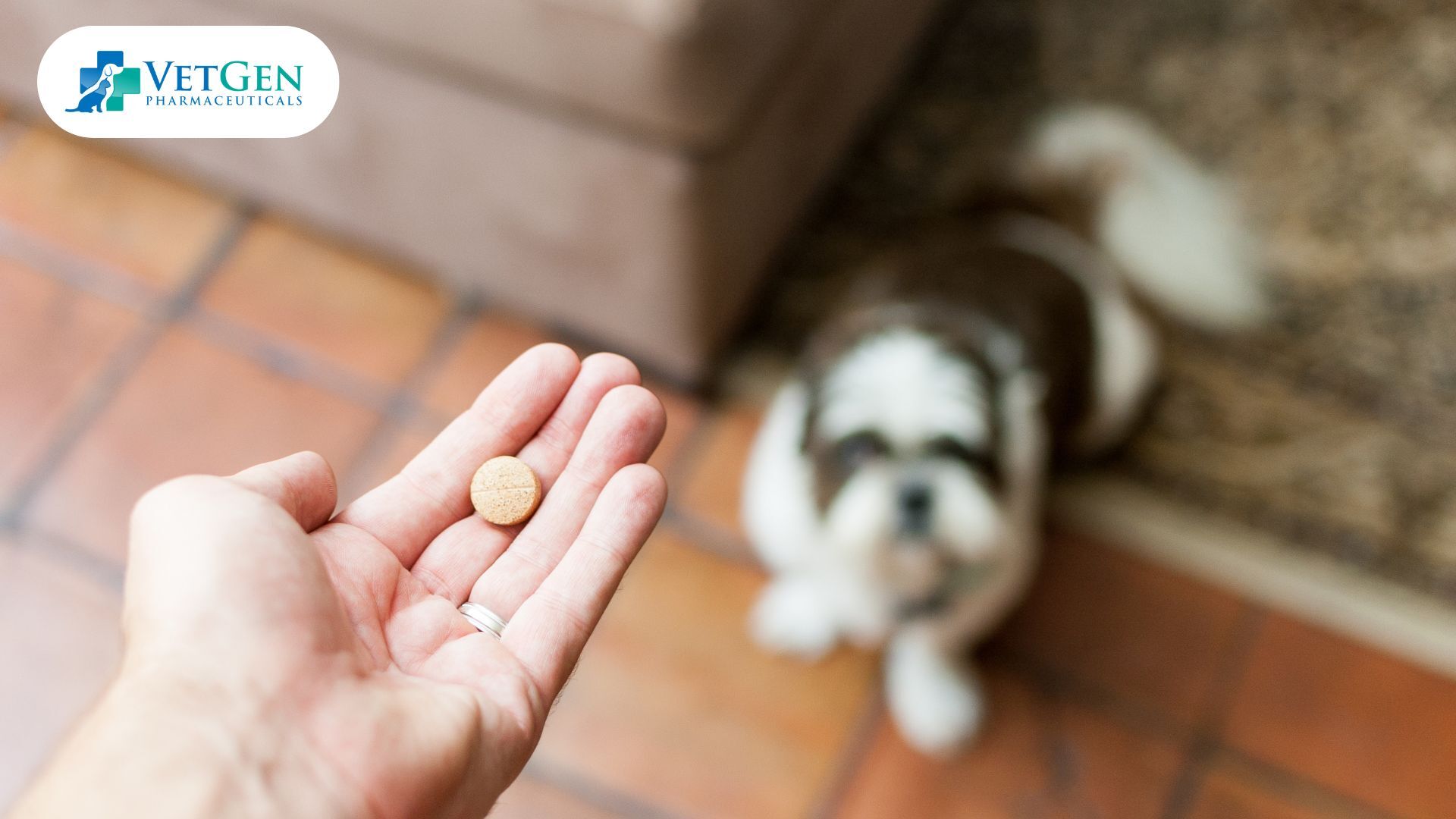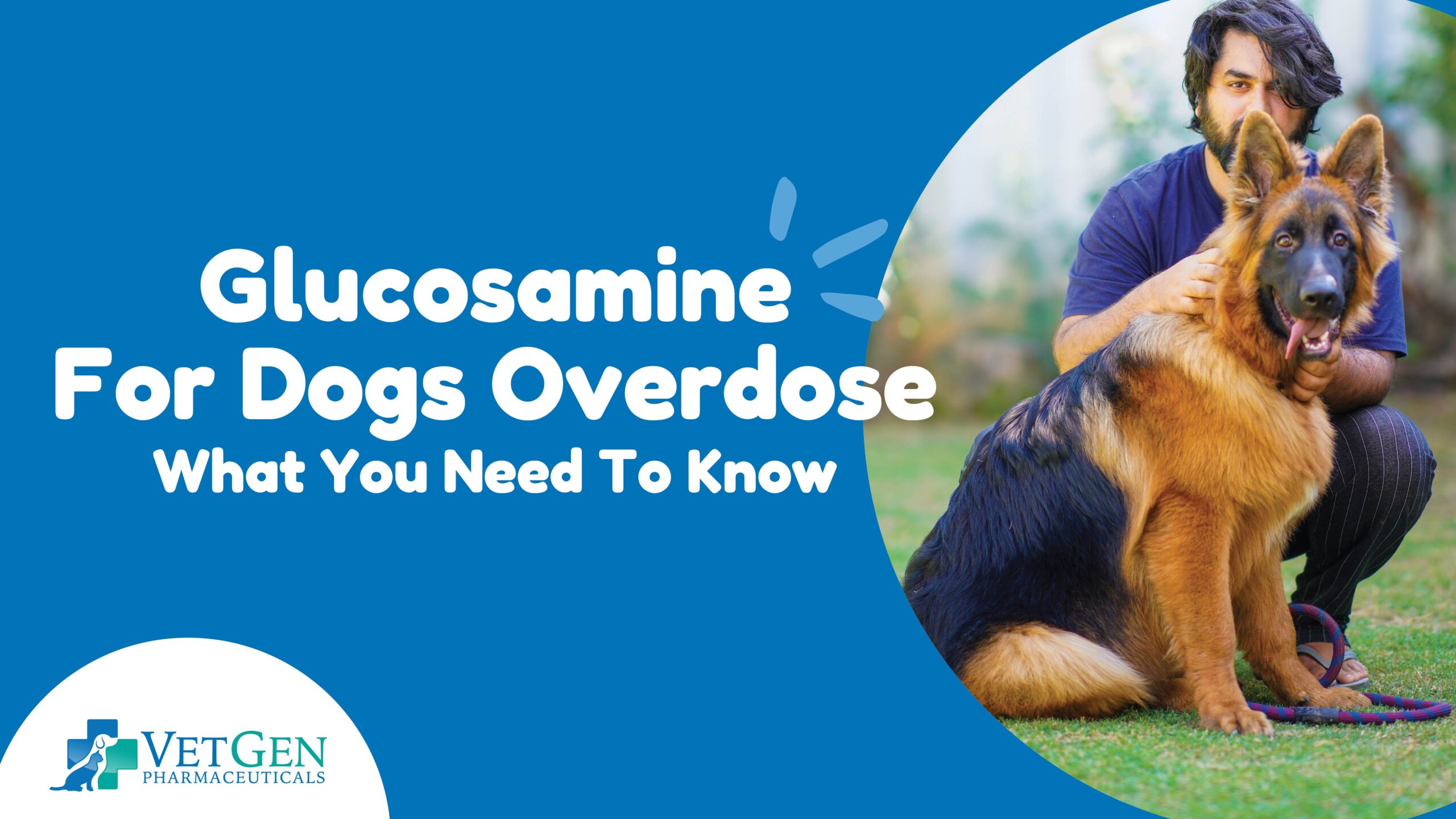Understanding Grain-Free Diets for Dogs
Glucosamine is a popular supplement many dog owners use to support their furry friend’s joint health. But did you know that too much of this beneficial compound can lead to dangerous side effects?
In this blog, we’ll discuss the importance of glucosamine for dogs, how it works, and what can happen if your beloved pet accidentally ingests too much.
We’ll also provide valuable advice on preventing overdoses and recognizing signs of toxicity
Key Takeaways
Glucosamine For Dogs: What Is It And How Does It Work?
Glucosamine is a naturally occurring compound often extracted from shellfish and used as a supplement for dogs to improve joint health and reduce inflammation and pain.
A. How It Works For Joint Health
Glucosamine is a naturally occurring compound found in your dog’s body, specifically in the cartilage that cushions their joints. This essential component helps maintain the integrity and flexibility of joint tissues by promoting the production of glycosaminoglycans – crucial building blocks for maintaining healthy cartilage.
Supplementing with glucosamine can help alleviate this issue as it possesses anti-inflammatory properties. Doing so can support your furry companion’s joint health by reducing inflammation and encouraging new cartilage growth.
For example, suppose your dog suffers from arthritis or hip dysplasia. Adding glucosamine supplements to their diet may help them regain mobility over time while minimizing pain levels during daily activities like walking or playing fetch at the park.
B. Forms Available For Dogs
Glucosamine supplements come in various forms to cater to the preferences and needs of dogs and their owners. Here is a list of common forms available:
- Tablets: A popular choice due to their ease of administration, often featuring tasty flavors that dogs enjoy.
- Capsules: Provide an odor-free and tasteless alternative, which can be opened up and mixed with dog food if needed.
- Soft Chews: Similar to treats, these soft chews make administering glucosamine more enjoyable for your dog.
- Liquid Glucosamine: Easily mixed into your dog’s food or water, this option offers quick absorption into the body.
- Powder Forms: Often containing additional ingredients such as chondroitin and MSM, powder glucosamine is easily mixed with dog food.
- Glucosamine-Infused Dog Treats: Combining joint health benefits with a delicious treat, these are ideal for rewarding good behavior while providing essential nutrients.
Remember to consult with your veterinarian before introducing any new supplement into your dog’s diet, as they can help guide you toward the best form and dosage for your furry friend’s specific needs.
C. Benefits Of Glucosamine For Dogs
Glucosamine for dogs offers many benefits, especially in promoting joint health and alleviating pain associated with arthritis. As a natural anti-inflammatory agent, glucosamine aids in reducing swelling and discomfort in your dog’s joints.
One notable advantage of using glucosamine for dogs is its potential to enhance mobility and overall quality of life. For instance, senior dogs or those suffering from joint issues may find it difficult to move around comfortably or engage in activities they once enjoyed.
By providing a consistent dosage of glucosamine as part of their daily regimen, you can help support your furry friend by improving their joint function and range of motion.
This way, they’ll be more likely to experience increased comfort during walks or playtime with the family.
- Glucosamine is a popular supplement dog owners use to support joint health, but too much can lead to dangerous side effects like liver damage and failure.
- Symptoms of glucosamine overdose in dogs include vomiting, diarrhea, lethargy, increased thirst and urination, bruising or bleeding easily, and swollen belly or stomach pain.
- To prevent overdosing on glucosamine supplements in dogs, always follow the proper dosage guidelines recommended by your veterinarian. Give only recommended amounts. Consult your vet before introducing any new supplement into your dog’s diet.
- If you suspect your dog has overdosed on glucosamine supplements, seek emergency veterinary care immediately, as the treatment depends on the severity and timing of ingestion. Prevention is better than cure, so keep all medication out of reach from pets and children while monitoring their health closely for signs of side effects when taking any supplement or medication.

Risks Of A Glucosamine Overdose For Dogs
An overdose of glucosamine in dogs can lead to several risks, including symptoms like:
- Vomiting
- Diarrhea
- Loss of appetite
- Lethargy or weakness
- Increased thirst or urination
- Bruising or bleeding easily
- Swollen belly or stomach pain
- Jaundice (yellowing of the eyes or skin)
- Seizures or tremors
If your dog exhibits these symptoms after taking glucosamine supplements, contact your veterinarian immediately.
It is important to seek veterinary care as soon as possible because liver damage caused by glucosamine overdose can progress rapidly and compromise your dog’s health.
In severe cases, liver failure caused by glucosamine poisoning can be life-threatening.
To prevent accidental overdosing on glucosamine supplements, always follow the proper dosage guidelines recommended by your veterinarian.
Do not give your dog more than the recommended amount, even if it will provide additional relief. Also, choose reputable brands and products that have undergone rigorous testing and quality control measures to ensure that they contain accurate glucosamine dosages and no harmful additives or fillers.
Risks:
The most common risk of a glucosamine overdose is liver damage, leading to liver failure and even death in severe cases.
It’s important to note that unregulated supplements could contain other toxic ingredients for dogs that may exacerbate these symptoms.
How Much is Too Much?
It is important to understand that the amount of glucosamine that is safe for dogs can vary depending on their size and weight. Typically, the recommended dose of glucosamine for a dog is between 500mg to 1000mg per day.
In fact, even a quarter of the lethal dose (around 8000 mg/kg or about 16,000 mg/lb) of glucosamine can be fatal for a dog. Therefore, following proper dosage guidelines is essential, and avoiding over-supplementing your furry friend with too much of this joint health supplement.
Risks Of A Glucosamine Overdose For Dogs
If you suspect your dog has overdosed on glucosamine, seek emergency veterinary care immediately; the treatment for a glucosamine overdose depends on the severity and timing of ingestion.
1. Emergency Treatment
In case of a glucosamine overdose in your dog, acting fast and seeking emergency veterinary care immediately is crucial. Here are some key steps to take:
- Bring the bottle or packaging of the supplement that your dog consumed.
- Provide your vet with as much information as possible about the type, dosage, and timing of the glucosamine your dog ingested.
- The veterinarian may induce vomiting to remove any remaining glucosamine from your pet’s stomach.
- If necessary, activated charcoal may be administered to absorb any remaining toxins in the digestive system.
- Your vet may also perform diagnostic tests like blood work, urinalysis, and X-rays to assess liver function, kidney function, blood clotting times, and more.
- Treatment for liver failure caused by glucosamine overdose in dogs usually requires hospitalization, fluids, liver-protecting medications, blood work, and sometimes blood transfusions.
Remember that prevention is always better than cure when it comes to medication poisoning in dogs. Keep all supplements securely locked away and out of reach from pets and children, and consult with a veterinarian before giving your dog any new medication or supplement.
2. How To Prevent Overdose
Preventing a glucosamine overdose in dogs is important to ensure their safety and well-being.
Firstly, always follow the recommended dosage guidelines provided by your veterinarian or on the supplement packaging. Overdosing can happen when pet owners assume that “more is better.”
Thirdly, research reputable brands before purchasing supplements for your furry friend, as many unregulated products may contain harmful ingredients.
Finally, monitor your dog’s health closely for signs of side effects such as vomiting or diarrhea after taking supplements.

Avoiding Glucosamine Overdose In The Future
To avoid glucosamine overdose in the future, always follow proper dosage guidelines, use reputable brands, and monitor your dog’s health. Consider alternative supplements or pain medications and talk to your vet before starting any new treatment.
1. Proper Dosage Guidelines
Giving your dog the correct dosage of glucosamine and chondroitin is crucial for optimal effectiveness. Here are some recommended guidelines to follow when giving your dog joint supplements:e are some key steps to take:
- Always consult with your veterinarian before starting your dog on any new supplements or medications.
- Read the label carefully and follow the recommended dosage instructions.
- Consider your dog’s weight, age, and overall health when determining the appropriate dosage.
- Start with a smaller dosage and gradually increase it over time if necessary.
- Do not exceed the recommended dosage, which can lead to an overdose.
- Monitor your dog’s reaction to the supplement and adjust the dosage accordingly.
- Contact your veterinarian for guidance if you have any concerns or questions about dosing.
Remember that too much glucosamine or chondroitin can harm your dog’s liver and overall health. By following proper dosage guidelines, you can help ensure that your furry friend gets the benefits of joint supplements without any negative side effects.
2. Using Reputable Brands
Choosing a high-quality glucosamine supplement from a reputable brand is crucial when giving it to your dog. With the industry’s lack of regulation, many supplements are available that may contain other toxic ingredients that could harm your furry friend.
3. Monitoring Your Dog's Health
When giving them glucosamine or other supplements, it is crucial to monitor your dog’s health. Regular check-ups with a veterinarian can help catch potential health issues, and monitoring for overdose symptoms is essential.
In addition to regular vet visits and watching out for symptoms of an overdose, monitoring your pet’s weight and mobility can also be useful in determining if the supplement is working effectively.

Alternative Supplements
Dog owners can explore alternative supplements such as Omega-3 fatty acids, chondroitin sulfate, and MSM, as well as pain medications and physical therapy for managing joint pain in dogs.
Alternative Supplements
Several alternative supplements can help treat joint pain and inflammation in dogs. Here are some of the most popular options:
If you’re looking for alternatives to glucosamine for managing your dog’s joint pain, consider the following:
- Omega-3 Fatty Acids: These essential fatty acids can reduce inflammation and improve joint mobility in dogs. They can be found in fish oil supplements or foods like salmon and sardines.
- MSM: MSM is a natural supplement that supports joint health by reducing inflammation and promoting healing.
- Green-Lipped Mussel: This type of shellfish contains anti-inflammatory compounds, including omega-3 fatty acids and glycosaminoglycans (GAGs). GAGs are natural building blocks of cartilage and can help improve joint health in dogs.
- Turmeric: This spice contains a compound called curcumin, which has potent anti-inflammatory properties. Adding turmeric to your dog’s food or giving them a turmeric supplement can help ease joint pain.
- Devil’s Claw: This herb has anti-inflammatory properties and may help relieve pain.
- Boswellia: Boswellia is another herb with anti-inflammatory properties, making it a popular supplement for treating joint pain in dogs.
- Physical Therapy: Exercise and physical therapy can help strengthen your dog’s muscles and reduce stress on their joints. Consult with a veterinarian or canine rehabilitation specialist to develop an appropriate exercise program for your dog.
- Pain Medications: In some cases, prescription pain medications may be necessary to manage severe joint pain in dogs. Talk to your veterinarian about whether this is an appropriate option for your dog.
It is important to note that while these supplements can be effective, they should be used under the guidance of a veterinarian. Choosing high-quality products made specifically for dogs to ensure their safety and efficacy is also a good idea.
Pain Medications
If your dog suffers from joint pain, pain medications may be a viable option to help alleviate their discomfort. Here are some important facts to keep in mind:
- A veterinarian can prescribe pain medications for dogs, and should only be given with their approval.
- Common pain medications for dogs include nonsteroidal anti-inflammatory drugs (NSAIDs), opioids, and corticosteroids.
- NSAIDs are often used to treat joint pain but can have side effects, including stomach ulcers and kidney damage.
- Opioids can provide effective pain relief but can also cause sedation and constipation.
- Corticosteroids are typically used for short-term treatment of inflammation but should not be used long-term as they can have severe side effects such as liver disease or Cushing’s disease.
- Pain medication dosages will depend on the dog’s weight and condition, and it’s essential to follow the veterinarian’s instructions carefully.
- Monitoring your dog’s health while taking pain medications is crucial, as some side effects may require immediate medical attention.
As with any medication or supplement, it’s vital to consult with a qualified veterinarian before administering pain medications to your dog. In some cases, combining pain medication with glucosamine or alternative supplements may provide additional relief for joint pain symptoms.
Physical Therapy
Physical therapy can be an effective treatment for joint pain in dogs, especially when used in conjunction with glucosamine supplements and other therapies. Here are some key facts about physical therapy for dogs:
- Physical therapy can improve joint mobility and flexibility, reduce pain and inflammation, and help build strength in muscles that support the joints.
- Depending on the root cause of your dog’s joint pain, different types of therapies may be recommended, including hydrotherapy, massage, stretching exercises, and more.
- In some cases, physical therapy can help reduce the need for prescription pain medications or delay the need for surgery.
- Physical therapy should always be done under the guidance of a licensed veterinarian or certified canine rehabilitation therapist to ensure proper technique and safety.
- Like any treatment option, physical therapy may not work for every dog or every situation – it’s important to work closely with your veterinarian to tailor a treatment plan that works best for your pet.
Remember that while physical therapy can be beneficial, it is not a substitute for proper nutrition, exercise, and other preventative care measures that can help keep your dog healthy over the long term.
By working closely with your veterinarian and exploring a range of treatment options like glucosamine supplements, physical therapy, and proper diet and exercise plans, you can help your furry friend maintain optimal health throughout their life!

Conclusion: Keeping Your Dog Safe And Healthy With Glucosamine.
In conclusion, while glucosamine can be an excellent option for treating joint pain in dogs, it’s crucial to understand the risks involved with overdosing.
Knowing what symptoms to look out for and how much is too much can help you keep your furry friend safe. Additionally, always use reputable brands and closely monitor your dog’s health when administering supplements.
Remember that alternative options are available for treating joint pain, so consult with your veterinarian to find the right solution for your pup.






